pacific ocean
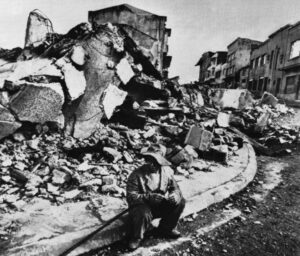
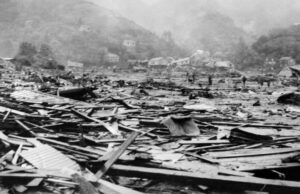 I would never have considered that an earthquake in Chili could affect Hawaii, which is 6,593 miles away, but on May 23, 1960, that seemingly huge distance suddenly became very small. When a 9.5 magnitude earthquake hit Chili on May 22, 1960, thousands of people lost their lives, and a giant tsunami was triggered. By the next day, that tsunami had traveled across the Pacific Ocean and killed an additional 61 people in Hilo, Hawaii. That distance and the amount of devastation seems incredible to me.
I would never have considered that an earthquake in Chili could affect Hawaii, which is 6,593 miles away, but on May 23, 1960, that seemingly huge distance suddenly became very small. When a 9.5 magnitude earthquake hit Chili on May 22, 1960, thousands of people lost their lives, and a giant tsunami was triggered. By the next day, that tsunami had traveled across the Pacific Ocean and killed an additional 61 people in Hilo, Hawaii. That distance and the amount of devastation seems incredible to me.
The earthquake, which involved a severe plate shift, caused a large displacement of water just off the coast of southern Chile at 3:11pm. The resulting wave, traveling at speeds in excess of 400 miles per hour, moved west and north. The damage to the west coast of the United States was estimated at $1 million, but there were no deaths there.
In 1948, the Pacific Tsunami Warning System was established in response to another deadly tsunami. It worked properly and warnings were issued to Hawaiians six hours before the deadly wave was expected to arrive. Unfortunately, some people ignored the warnings, as always seems to happen. Some other people actually headed to the coast in order to view the wave…like the warning was actually an announcement of a coming attraction. The tsunami arrived only a minute after it was predicted, and it absolutely destroyed Hilo Bay on the island of Hawaii.
People really don’t fully understand just how much destructive power water has, until they see it in action. When the waves hit Hilo Bay, they were thirty-five-feet high. They were so strong that they bent parking meters to the ground and wiped away most of the buildings. When the wave hit a 10-ton tractor, it was swept out to sea like it was made of Styrofoam. you would think that boulders would be sturdy enough to hold back the waves, but the 20-ton boulders that made up the seawall were easily moved 500 feet. The 61 people who lost their lives were in Hilo…the hardest hit area of the island chain.
With all of that destruction, you might be inclined to think that the waves would have lost power, and to a degree, I suppose they did. Nevertheless, the tsunami continued to race further west across the Pacific. Even given a ten-thousand-mile distance from the earthquake’s epicenter, Japan still wasn’t able to provide enough warning time to get the people out of harm’s way. The wave hit Japan at about 6:00pm, more than a full day after the earthquake. The tsunami struck the Japanese islands of Honshu and Hokkaido. The wave’s power was still enough to crushing 180 people, and to leave 50,000 more homeless. In Japan, it caused $400 million in 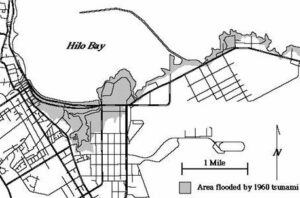
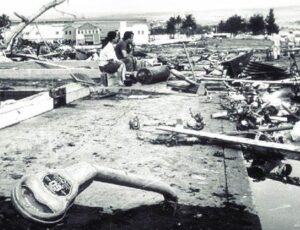 damages. With everything destroyed by this one earthquake and the subsequent tsunami, you would think that people would finally learn to stay away from the shore during a tsunami warning, but every year people lose their lives because they decided to cross paths with waves…be it from tsunamis, hurricanes, and other floods. Water is a force to be reckoned with. It should be considered very dangerous.
damages. With everything destroyed by this one earthquake and the subsequent tsunami, you would think that people would finally learn to stay away from the shore during a tsunami warning, but every year people lose their lives because they decided to cross paths with waves…be it from tsunamis, hurricanes, and other floods. Water is a force to be reckoned with. It should be considered very dangerous.
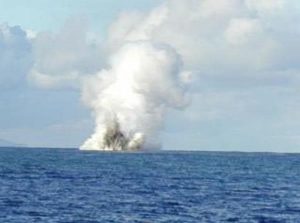 I realize that many people, me included, would have no desire to explore the inside of a volcano, but for scientists of volcanos…volcanologists, it is somehow important. A dormant volcano would be fairly easy to explore. There is less chance of getting caught in an eruption, but for one that isn’t dormant, it isn’t so easy. I don’t think I would want to try to explore Kilauea, because…well, it goes up all the time. Another very active volcano, Kavachi is not only active, but it is underwater. Kavachi is located in the south-west Pacific Ocean, south of Vangunu Island in the Solomon Islands. and is referred to locally as Rejo te Kavachi, meaning “Kavachi’s oven.” Kavachi has become active and then eroded back into the sea at least eight times since its first recorded eruption in 1939.
I realize that many people, me included, would have no desire to explore the inside of a volcano, but for scientists of volcanos…volcanologists, it is somehow important. A dormant volcano would be fairly easy to explore. There is less chance of getting caught in an eruption, but for one that isn’t dormant, it isn’t so easy. I don’t think I would want to try to explore Kilauea, because…well, it goes up all the time. Another very active volcano, Kavachi is not only active, but it is underwater. Kavachi is located in the south-west Pacific Ocean, south of Vangunu Island in the Solomon Islands. and is referred to locally as Rejo te Kavachi, meaning “Kavachi’s oven.” Kavachi has become active and then eroded back into the sea at least eight times since its first recorded eruption in 1939.
It is very strange to me to see pictures and videos of volcano erupting in the middle of the ocean. It seems so unnatural that fire and water could mix and the water not put out the fire. It’s a strange concept, but one that has baffled me for years. I think that the thought of fire and water has maybe been the curiosity behind the exploration of these underwater volcanoes. In May 2000, an international research team aboard the CSIRO 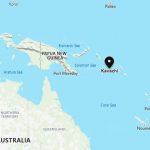 research vessel Franklin fixed the Kavachi volcano at 8° 59.65’S, 157° 58.23’E. The vent of the volcano was below sea level, but frequent eruptions ejected molten lava up to 230 feet above sea level, and sulfurous steam plumes up to 1,600 feet. The team mapped a roughly conical feature rising from 3,600 feet water depth, with the volcano having a basal diameter of about 5.0 miles. Of course, underwater volcanoes were the foundation of the Hawaiian Islands, so it is not a odd idea that when the Kavachi volcano erupted in 2003, a 49-foot island formed above the surface. The small island disappeared a short time later, so I suppose the volcano would have to erupt almost constantly in order to form an island that would last.
research vessel Franklin fixed the Kavachi volcano at 8° 59.65’S, 157° 58.23’E. The vent of the volcano was below sea level, but frequent eruptions ejected molten lava up to 230 feet above sea level, and sulfurous steam plumes up to 1,600 feet. The team mapped a roughly conical feature rising from 3,600 feet water depth, with the volcano having a basal diameter of about 5.0 miles. Of course, underwater volcanoes were the foundation of the Hawaiian Islands, so it is not a odd idea that when the Kavachi volcano erupted in 2003, a 49-foot island formed above the surface. The small island disappeared a short time later, so I suppose the volcano would have to erupt almost constantly in order to form an island that would last.
Of course, that strangest thing about Kavachi is that while the volcano is quite active, it has another strange anomaly to it. In 2015, marine life has been found living inside the Kavachi crater, including two species of sharks and a sixgill stingray. It seems so strange that they could live in an environment that must be quite acidic. The scientists haven’t been able to go in and explore yet, because of the possibility of an eruption. 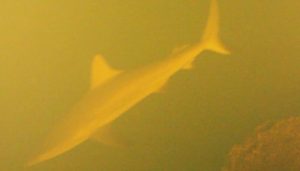 Finally they took a chance and dropped a camera into the volcano. Concerned about activity from the volcano, the expedition members only left the camera in the hot, acidic water around the volcano for about an hour. Still, it was all they needed to find the wildlife inside. Of course, during an eruption, there is no way this marine life could live inside the volcano. That makes me wonder if they somehow know the eruption is coming so they can get out, or do they simply die when an eruption occurs. That somehow doesn’t seem like the case, because eventually there would be no more marine life in the volcano. I guess that is just a question we will probably never have an answer to.
Finally they took a chance and dropped a camera into the volcano. Concerned about activity from the volcano, the expedition members only left the camera in the hot, acidic water around the volcano for about an hour. Still, it was all they needed to find the wildlife inside. Of course, during an eruption, there is no way this marine life could live inside the volcano. That makes me wonder if they somehow know the eruption is coming so they can get out, or do they simply die when an eruption occurs. That somehow doesn’t seem like the case, because eventually there would be no more marine life in the volcano. I guess that is just a question we will probably never have an answer to.
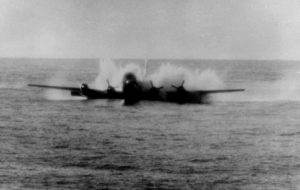 Very few people these days haven’t heard of Captain Chesley B. “Sulley” Sullenberger III and co-pilot Jeff Skiles who made their now famous landing on the Hudson River in New York City after a bird strike left them powerless. We all know that everyone “miraculously” survived that crash landing. It was an undeniable miracle, but it was not the first time such a thing had happened. On October 16, 1956, Pan Am Flight 6, a Boeing 377 Stratocruiser on a nighttime flight from Honolulu to San Francisco, developed engine trouble in one and then two of its four engines. Pan Am Flight 6 was about halfway across the Pacific Ocean at the time and the malfunctioning engine propeller sent the airplane into a descent. I can only imagine the thoughts racing through the minds of the pilots, given the fact that they were not going to find a highway or a field on which to land safely. There was only ocean. This was not the first time a plane had to ditch in the ocean, but I doubt that was any comfort to the men who were flying the plane, since the other ditching events had fatalities.
Very few people these days haven’t heard of Captain Chesley B. “Sulley” Sullenberger III and co-pilot Jeff Skiles who made their now famous landing on the Hudson River in New York City after a bird strike left them powerless. We all know that everyone “miraculously” survived that crash landing. It was an undeniable miracle, but it was not the first time such a thing had happened. On October 16, 1956, Pan Am Flight 6, a Boeing 377 Stratocruiser on a nighttime flight from Honolulu to San Francisco, developed engine trouble in one and then two of its four engines. Pan Am Flight 6 was about halfway across the Pacific Ocean at the time and the malfunctioning engine propeller sent the airplane into a descent. I can only imagine the thoughts racing through the minds of the pilots, given the fact that they were not going to find a highway or a field on which to land safely. There was only ocean. This was not the first time a plane had to ditch in the ocean, but I doubt that was any comfort to the men who were flying the plane, since the other ditching events had fatalities.
Pan Am World Airways first started flying in 1927, delivering mail between Florida and Cuba. The carrier was based out of New York City for nearly 30 years, until it went out of business in 1991. The airline left a legacy of firsts. “It was first across the Atlantic, first with flights across the Pacific and the first to offer around-the-world service,” said Kelly Cusack, the curator of the Pan Am Museum Foundation. Most airlines celebrate a lot of their firsts, but there is one first that no airline wants to celebrate, or have on their list of firsts at all…a crash. Nevertheless, on October 16, 1956, a crash was exactly what was going to happen. This crash took place 53 years before “Sulley’s” famous water landing into the Hudson River. “This is a particularly memorable and a proud part of our legacy because of two words: happy ending,” said Jeff Kriendler, who was Pan Am’s vice president for corporate communications in the 1980s and has written several anthologies about the airline. Airlines have ditched in the ocean before, but this was the first to do so with no fatalities. Like “Sulley’s” famous flight, ditching in the ocean without fatalities…was unheard of. Unlike “Sulley’s” landing, which was caught on camera, a nighttime flight in the middle of the ocean in 1956 was not likely to be caught on camera.
The flight started out smoothly, but then developed engine trouble in one, and then two of its four engines. Pan  Am Flight 6 was about halfway across the Pacific Ocean at the time and the malfunctioning engine propeller sent the airplane into a descent. The decision to land the plane in the sea with 24 passengers and seven crew members aboard was not made until all other options had been considered. Captain Richard Ogg, the pilot, wrote an account of the episode a year later, saying that he had to weigh many factors. Should he jettison fuel and try to land on the water immediately or fly until daylight provided better visibility? One thing was clear, the bad propeller was causing the plane to burn fuel too fast. He would not make it to San Francisco or Honolulu. Apparently, it was no coincidence that the ship was nearby. In the early days of long flights over water, Coast Guard ships were positioned in the Pacific and the Atlantic Oceans, offering weather information to flight crews and relaying radio messages, according to Doak Walker, a Coast Guard historian who participated in the rescue of Flight 6. In preparation, the cutters were placed near what was expected to be the point of no return. That is the area where a plane would have burned too much fuel to turn back in case of an emergency.
Am Flight 6 was about halfway across the Pacific Ocean at the time and the malfunctioning engine propeller sent the airplane into a descent. The decision to land the plane in the sea with 24 passengers and seven crew members aboard was not made until all other options had been considered. Captain Richard Ogg, the pilot, wrote an account of the episode a year later, saying that he had to weigh many factors. Should he jettison fuel and try to land on the water immediately or fly until daylight provided better visibility? One thing was clear, the bad propeller was causing the plane to burn fuel too fast. He would not make it to San Francisco or Honolulu. Apparently, it was no coincidence that the ship was nearby. In the early days of long flights over water, Coast Guard ships were positioned in the Pacific and the Atlantic Oceans, offering weather information to flight crews and relaying radio messages, according to Doak Walker, a Coast Guard historian who participated in the rescue of Flight 6. In preparation, the cutters were placed near what was expected to be the point of no return. That is the area where a plane would have burned too much fuel to turn back in case of an emergency.
Ogg opted to fly an eight-mile circuit above the Pontchartrain until morning while planning for the water landing. Remembering that during another Pan Am Stratocruiser ditching, the tail had broken off, Ogg had the passengers in the back of the plane move forward and asked those seated by the engine to move as well. “We will try to stay aloft until daylight,” Ogg radioed to the Pontchartrain. When the passengers learned the flight would circle and not attempt to land in the dark, “it gave them a lot of confidence,” said Frank Garcia, 91, the flight engineer and a guest of honor at the Pan Am event. Passengers were also comforted knowing “someone was out there waiting to give them as much aid as they can,” Garcia said. Standing watch on the cutter just after 8 a.m., Walker, 83, recalled that “the seas were extremely calm and the weather was good and we were hoping there wouldn’t be much of a problem.”
Just as Ogg had expected, the tail broke off as soon as the plane hit the sea. Then the nose of the airliner went under the water. “I felt as if somebody had grabbed the seat of my pants and was pulling,” Garcia said. “I saw the water. I was more frightened if the windows broke, then the water would come in.” From the cockpit,  all Garcia saw was water. “I can’t tell you how many seconds, it was less than a minute, and I saw the water receding,” Garcia said, as the front of plane surfaced. On the Pontchartrain many thought they had just witnessed a disaster, Walker said. “It was so sad,” he said. “We knew nobody could survive that.” Rescue boats sped toward the plane, while other Coast Guardsmen filmed the event. Captured moments included life rafts bobbing by the aircraft’s fuselage, transferring survivors to rescue boats, the sinking plane, and the lifting of twin toddlers, Maureen and Elizabeth Gordon, from a lifeboat into waiting seamen’s arms. And, everyone was saved. It was a miracle at sea.
all Garcia saw was water. “I can’t tell you how many seconds, it was less than a minute, and I saw the water receding,” Garcia said, as the front of plane surfaced. On the Pontchartrain many thought they had just witnessed a disaster, Walker said. “It was so sad,” he said. “We knew nobody could survive that.” Rescue boats sped toward the plane, while other Coast Guardsmen filmed the event. Captured moments included life rafts bobbing by the aircraft’s fuselage, transferring survivors to rescue boats, the sinking plane, and the lifting of twin toddlers, Maureen and Elizabeth Gordon, from a lifeboat into waiting seamen’s arms. And, everyone was saved. It was a miracle at sea.
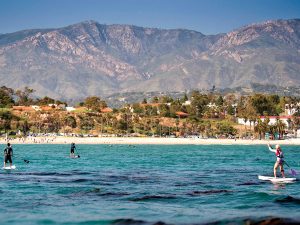
 Santa Barbara, California is a picturesque area with mountains to the east, ocean to the west, and palm trees everywhere. It seems like a perfect kind of paradise, and most of the time it probably is, but on June 29, 1925, many things changed. That morning, a magnitude between 6.5 and 6.8 earthquake hit the area of Santa Barbara. Although no foreshocks were reportedly felt before the mainshock, a pressure gauge recording card at the local waterworks showed disturbances beginning at 3:27am, which were likely caused by minor foreshocks. Then, at 6:44am the mainshock occurred, lasting 19 seconds. The earthquake’s epicenter was in the Pacific Ocean off the coast of Santa Barbara, in the Santa Barbara Channel. It is thought that the fault on which it occurred is an extension of the Mesa fault or the Santa Ynez system. The earthquake was felt from Paso Robles in San Luis Obispo County to the north to Santa Ana in Orange County to the south and to Mojave in Kern County to the east. Major damage occurred in the city of Santa Barbara and along the coast, as well as north of Santa Ynez Mountains, including Santa Ynez and Santa Maria valleys.
Santa Barbara, California is a picturesque area with mountains to the east, ocean to the west, and palm trees everywhere. It seems like a perfect kind of paradise, and most of the time it probably is, but on June 29, 1925, many things changed. That morning, a magnitude between 6.5 and 6.8 earthquake hit the area of Santa Barbara. Although no foreshocks were reportedly felt before the mainshock, a pressure gauge recording card at the local waterworks showed disturbances beginning at 3:27am, which were likely caused by minor foreshocks. Then, at 6:44am the mainshock occurred, lasting 19 seconds. The earthquake’s epicenter was in the Pacific Ocean off the coast of Santa Barbara, in the Santa Barbara Channel. It is thought that the fault on which it occurred is an extension of the Mesa fault or the Santa Ynez system. The earthquake was felt from Paso Robles in San Luis Obispo County to the north to Santa Ana in Orange County to the south and to Mojave in Kern County to the east. Major damage occurred in the city of Santa Barbara and along the coast, as well as north of Santa Ynez Mountains, including Santa Ynez and Santa Maria valleys.
Those were 19 seconds that started a disaster of epic proportions. The earthquake was immediately complicated when the dam broke and water mains burst. The earthen Sheffield Dam had been built near the city in 1917. It was 720 feet long and 25 feet high and held 30 million gallons of water. The soil under the dam liquefied during the earthquake and the dam collapsed. This was the only dam to fail during an earthquake in the United States until the Lower San Fernando Dam failed in 1971. When it burst, a wall of water swept between Voluntario and Alisos Streets destroying trees, cars, three houses and flooding the lower part of town to a depth of 2 feet. The rushing water caused some areas of the city to be flattened. People as far away as San Francisco and Los Angeles felt the earthquake, reporting millions of dollars worth of damage across California. The earthquake was even felt in other states as far away as Montana, who reported more damage. The earthquake destroyed the historic center of the city, with damage estimated at $8 million in 1925, or about $117 million today.
Thirteen people lost their lives that day, but it may have been far worse without the actions of three heroes. Those heroes shut off the town gas and electricity preventing a catastrophic fire. Most homes survived the earthquake in relatively good condition, with the exception of the fact that every chimney in the city crumbled. The downtown area of Santa Barbara was in complete ruins. On State Street, the main commercial street, only a few buildings remained standing after the earthquake. The City Cab building, The Californian, and Arlington garages…all large and fully occupied parking structures…collapsed. They were full of cars. Many other vehicles were crushed in the downtown area too. At least one death was the result of the San Marcos building crushing a car, as walls of buildings fell onto cars parked there. In the 36 block business district, only a few structures were not substantially damaged. Many had to be completely demolished and rebuilt. The façade of the church of the Mission Santa Barbara was severely damaged and lost its statues. Many important buildings, including hotels, offices, and the Potter Theater, were lost. The courthouse, jail, library, schools, and churches were among the buildings sustaining serious damage. Concrete curbs buckled in almost every block in Santa Barbara. Pavement on the boulevard along the beach was displaced by about a foot to a foot and a half, but oddly, the pavement in the downtown area was virtually not damaged.
Railroad tracks were damaged in several places between Ventura and Gaviota. In particular, a portion between Naples and Santa Barbara was badly damaged. Seaside bluffs fell into the ocean, and a slight tsunami was felt by offshore ships. The town was completely cut off from telephone and telegraph, and the only source of news was from shortwave radios. Because the gas was shut off, there was an absence of post-earthquake fires. This allowed scientists to study earthquake damage to various types of construction. That was a rare things for the scientists. The American Legion and the Naval Reserves from the Naval Reserve Center Santa Barbara patrolled the streets looking to inhibit looters of the damaged businesses and homes. Additional fire and police personnel arrived from as far as Los Angeles to assist the sailors and soldiers in maintaining order. Three strong aftershocks occurred at 8:00am, 10:45am, and 10:57am, but without further damage. There were many smaller shocks that continued throughout the day. An aftershock on July 3 caused additional cracked walls and damaged chimneys. Since downtown Santa Barbara suffered so much damage, there was a large-scale construction effort in 1925 and 1926 aimed at removing or repairing damaged structures and constructing new buildings. This new construction completely altered the character of the city center. Before the earthquake, a considerable part of the center was built in the Moorish Revival style. After the earthquake, the decision was made to rebuild it in the Spanish Colonial Revival style. This effort was undertaken by the Santa Barbara Community Arts Association, which was founded in the beginning of the 1920s and viewed the earthquake as the opportunity to rebuild the city center in the unified architectural style. As a result, many buildings later 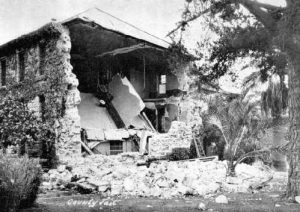
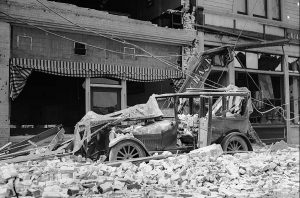 listed on National Register of Historic Places were designed in the late 1920s, among them the Santa Barbara County Courthouse and the front of the Andalucia Building. Building codes in Santa Barbara were also made more stringent after the earthquake demonstrated that traditional construction techniques of unreinforced concrete, brick, and masonry were unsafe and unlikely to survive strong quakes.
listed on National Register of Historic Places were designed in the late 1920s, among them the Santa Barbara County Courthouse and the front of the Andalucia Building. Building codes in Santa Barbara were also made more stringent after the earthquake demonstrated that traditional construction techniques of unreinforced concrete, brick, and masonry were unsafe and unlikely to survive strong quakes.
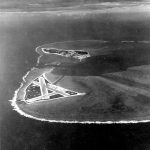 It’s a tiny island in the middle of the vast Pacific Ocean, so what possible impact could a battle for control of Midway Island have had? The answer is…much more than you might think. Sometimes, it’s not about the size of the nation, but rather about the might of its army. Japan is a little nation, it had built a mighty army and it was systematically defeating the Allies. Although other battles would soon make Midway seem like a small battle, no naval battle of World War II…and few others, if any, in all of naval history…would have so many momentous consequences ascribed to it as this one battle. So complete was Japan’s defeat at Midway, and so stunned was the Imperial High Command, that it would keep the results of the battle a secret from the Japanese people for the rest of the World War II.
It’s a tiny island in the middle of the vast Pacific Ocean, so what possible impact could a battle for control of Midway Island have had? The answer is…much more than you might think. Sometimes, it’s not about the size of the nation, but rather about the might of its army. Japan is a little nation, it had built a mighty army and it was systematically defeating the Allies. Although other battles would soon make Midway seem like a small battle, no naval battle of World War II…and few others, if any, in all of naval history…would have so many momentous consequences ascribed to it as this one battle. So complete was Japan’s defeat at Midway, and so stunned was the Imperial High Command, that it would keep the results of the battle a secret from the Japanese people for the rest of the World War II.
The story of the battle has been told many times over the years, and Midway continues to hold an almost mysterious place in the collective memory of the United States Navy and the United States in general. However, in recent decades a new generation of scholars has studied the facts of the battle. In some ways they 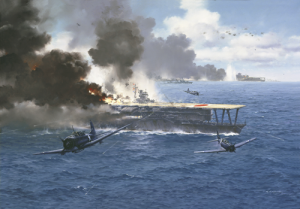 have removed the mystery of how such a “miracle” victory came to be and in other ways they have chalked it up to chance, luck, and the weather. The Americans had heard something about an attack, but the Japanese used the code location as “AF” to keep the attack location secret. The Americans suspected that it was Midway, so they sent a radio message that the island’s desalinization plant had broken down. The radio message was broadcast without encryption to ensure that Japan could read it if it was intercepted. The radio message was duly intercepted by Japan and reported by a message encoded in JN25 stating that AF’s desalinization plant was out of order and was intercepted by Station HYPO. “AF” was thus confirmed as Midway.
have removed the mystery of how such a “miracle” victory came to be and in other ways they have chalked it up to chance, luck, and the weather. The Americans had heard something about an attack, but the Japanese used the code location as “AF” to keep the attack location secret. The Americans suspected that it was Midway, so they sent a radio message that the island’s desalinization plant had broken down. The radio message was broadcast without encryption to ensure that Japan could read it if it was intercepted. The radio message was duly intercepted by Japan and reported by a message encoded in JN25 stating that AF’s desalinization plant was out of order and was intercepted by Station HYPO. “AF” was thus confirmed as Midway.
That was the beginning of the end for Japan. The Americans began to prepare for the attack. American scholars of Midway have long tried to explain away the many coincidences by characterizing the result of the battle as little short of a “miracle.” Walter Lord would name his 1967 narrative of Midway Incredible Victory, and 15 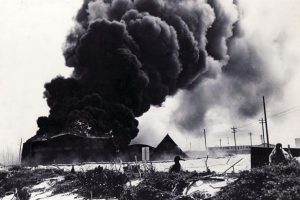 years later Gordon Prange’s posthumously published account of the battle was straightforwardly entitled Miracle at Midway. One battle participant’s memoir stated, “God was at Midway.” He saw divine intervention at work. The concept of the miracle has helped to explain the elements of the battle that have eluded detection, explication, or understanding. Some say that over the years, Midway has become less of a miracle, but that many mysteries remain. I say, that it was a miracle. God was at work at Midway. Even the weather worked against the Japanese when cloud cover prevented them from seeing what was right in front of them, and at the end of their attack…less than a week later, four Japanese fleet carriers would be twisted ruins on the bottom of the Pacific.
years later Gordon Prange’s posthumously published account of the battle was straightforwardly entitled Miracle at Midway. One battle participant’s memoir stated, “God was at Midway.” He saw divine intervention at work. The concept of the miracle has helped to explain the elements of the battle that have eluded detection, explication, or understanding. Some say that over the years, Midway has become less of a miracle, but that many mysteries remain. I say, that it was a miracle. God was at work at Midway. Even the weather worked against the Japanese when cloud cover prevented them from seeing what was right in front of them, and at the end of their attack…less than a week later, four Japanese fleet carriers would be twisted ruins on the bottom of the Pacific.

